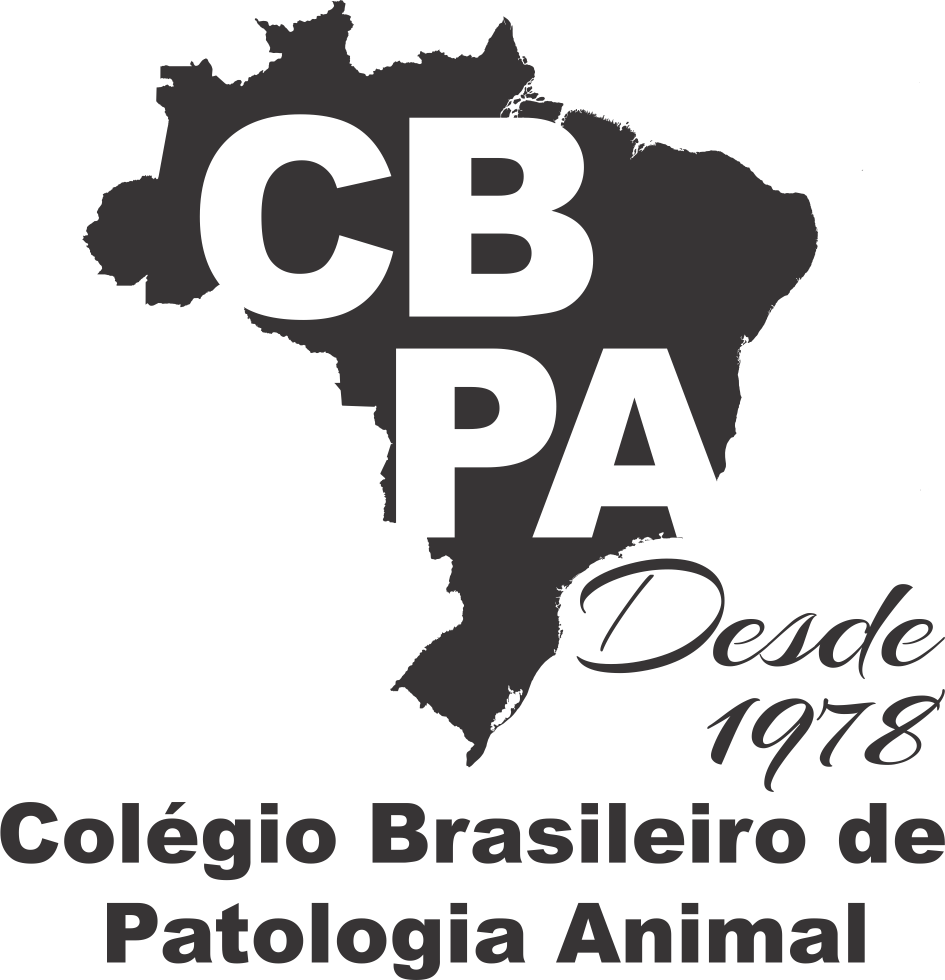Resultado da pesquisa (1016)
Termo utilizado na pesquisa bovinos
#1 - Spontaneous and experimental poisoning by Myrocarpus frondosus in cattle
Abstract in English:
An outbreak of photosensitization in Holstein and Jersey cattle occurred after the passage of an extratropical cyclone in Southern Brazil. On that occasion, several trees fell, including some of the species Myrocarpus frondosus (Fabaceae family) popularly known as “gabreúva”, “cabriúna” or “gabriúna”. Five heifers consumed the leaves of this plant, and all of them became ill. The main clinical signs were decreased appetite, permanence in the water, decreased ruminal movements, dry stools, congested and icteric sclera and conjunctivae, dark urine and restlessness when exposed to the sun. One heifer showed circling, incoordination, restlessness and death six days after the onset of clinical signs. From the seventh day, three heifers showed improvement; one remained apathetic, with jaundiced mucous membranes, ulceration, and scaling on the tongue, increased respiratory rate, and fever, and died 18 days after ingestion of the plant. At necropsy, photosensitivity lesions were observed on the depigmented skin, snout, teats, and ear tip, characterized by discontinuity of the skin with the formation of crusts, inflammatory exudate associated with redness of the skin, in addition to ulceration in the mouth, snout and ventral portion of the tongue and jaundice and edema in the submandibular region. The liver was enlarged, with an orange color, full gallbladder, and wall edema. Through microscopy, liver lesions were characterized by moderate and diffuse necrosis of hepatocytes, vacuolar and centrilobular degeneration, bilirubin retention and proliferation of biliary epithelium. The literature shows no reports of M. frondosus toxicity in cattle. Experiments were carried out in cattle to clarify the possible clinical-pathological picture produced by this plant. A survey of the epidemiological data of the diagnosed spontaneous outbreak was carried out, and subsequently, three cattle received the plant’s green leaves, and a fourth received the dried leaves. After administering the plant, blood samples were collected daily for blood count, measurement of liver enzymes (gamma glutamyl transferase, alkaline phosphatase, alanine aminotransferase, aspartate transferase), bilirubin, measurement of vital parameters and liver biopsy from the onset of signs. In case of death, a necropsy was performed with collection of viscera samples for macro and microscopic evaluation. The experimental part was developed at the Laboratory of Animal Pathology, CAV-UDESC. The single dose of 33g/kg of green leaves caused severe clinical signs, while the administration of 22g/kg and 11g/kg caused mild to moderate signs of the disease. The supply of desiccated leaves in a single dose did not cause clinical manifestations. M. frondosus can be blamed as a cause of spontaneous hepatogenous photosensitization in cattle. Experimentally, the ingestion of green leaves of this plant, in doses greater than 11g/kg can lead to clinical changes, with subsequent recovery, or progress to death with severe liver damage.
Abstract in Portuguese:
Um surto de fotossensibilização em bovinos da raça Holandesa e Jersey foi observado após a passagem de um ciclone extratropical no Sul do Brasil, quando houve queda de diversas árvores, dentre elas Myrocarpus frondosus (família Fabaceae), popularmente conhecida como “gabreúva, cabriúna ou gabriúna”. Cinco novilhas consumiram folhas dessa planta, e todas adoeceram. Os principais sinais clínicos foram diminuição do apetite, permanência dentro da água, diminuição dos movimentos ruminais, fezes ressecadas, esclera e conjuntivas congestas e ictéricas, urina escura e inquietação quando expostas ao sol. Uma novilha apresentou andar em círculos, incoordenação e inquietação e morte seis dias após início dos sinais clínicos. A partir do sétimo dia, três novilhas apresentaram melhora e uma permaneceu apática, com as mucosas ictéricas, ulceração e descamação na língua, aumento da frequência respiratória, febre e morreu 18 dias após ingestão da planta. Na necropsia foram observadas lesões de fotossensibilização na pele despigmentada, focinho, tetos, ponta da orelha, caracterizadas por descontinuidade da pele com formação de crostas, exsudato inflamatório associado a vermelhidão da pele além de ulceração na boca, focinho e porção ventral da língua e icterícia acentuada e edema, na região submandibular. O fígado estava aumentado de volume, de cor laranja, vesícula biliar repleta e com edema de parede. Através da microscopia foram observadas, lesões hepáticas, caracterizadas por necrose de hepatócitos, moderada e difusa, degeneração vacuolar, centrolobular, retenção de bilirrubina e proliferação de epitélio biliar. Na literatura, não há relatos da toxicidade de M. frondosus para bovinos. Com o objetivo de esclarecer o possível quadro clínico-patológico produzido por essa planta foram conduzidos experimentos em bovinos. Foi realizado um levantamento dos dados epidemiológicos do surto espontâneo diagnosticado e, posteriormente, três bovinos receberam as folhas verdes da planta e um quarto recebeu as folhas dessecadas. Após a administração da planta, foram coletadas amostras de sangue diariamente para hemograma, dosagem de enzimas hepáticas (gama glutamil transferase, fosfatase alcalina, alanina aminotransferase, aspartato transferase), bilirrubina, aferição dos parâmetros vitais e biópsia hepática a partir do surgimento dos sinais clínicos. Em caso de morte, foi realizada necropsia com coleta de amostras de vísceras para avaliação macro e microscópica. A parte experimental foi desenvolvida nas dependências do Laboratório de Patologia Animal, CAV-UDESC. A dose única de 33g/kg de folhas verdes causou graves sinais clínicos, enquanto a administração de 22g/kg e 11g/kg causou sinais leves a moderados da doença. O fornecimento de folhas dessecadas em dose única não causou manifestações clínicas. M. frondosus pode ser responsabilizada como causa de fotossensibilização hepatógena espontânea em bovinos. A ingestão de folhas verdes dessa planta em doses superiores a 11g/kg pode levar a alterações clínicas, com posterior recuperação, ou evoluir para morte com lesões hepáticas graves.
#2 - Wischnewsky spots in cases of fatal hypothermia in cattle
Abstract in English:
Wischnewsky spots (WS) are hemorrhagic, non-erosive, and non-ulcerative lesions that affect the gastric mucosa. They are considered common in the stomachs of humans who have died from hypothermia and are rarely described in other animal species. This study describes the occurrence of WS in cattle that had died of hypothermia in two cities in the state of Mato Grosso do Sul. Two properties were visited, and three cattle were necropsied by the team from the Pathological Anatomy Laboratory of the Federal University of Mato Grosso do Sul (LAP-UFMS). The epidemiological conditions and clinical signs of the cattle examined on both properties were similar. The deaths occurred on days when there was a sudden drop in environmental temperature, with continuous rain for more than 24 hours. During the visits, the most affected live cattle were found in sternal decubitus, with their heads resting on their flanks, or laterally in a comatose state, with nystagmus and a rectal temperature below 32°C. Macroscopically, there were multifocal to coalescent red and black areas on the mucosal surface of the abomasums of the three cattle necropsied, mainly at the apex of the folds, oval or punctate in shape, measuring 0.1 to 1.0cm in diameter. Microscopically, these dark areas corresponded to areas of rarefaction of the mucosal epithelial cells associated with hemorrhage and the frequent deposition of golden-brown pigment (hematin) in the extracellular medium. The diagnosis of hypothermia in cattle was based on epidemiology, clinical-pathological examination, and the exclusion of differential diagnoses. The lesions found in the abomasum of cattle that had died from hypothermia were compatible with WS, highlighting the importance of recognizing them in cases of cattle deaths in which this condition is suspected.
Abstract in Portuguese:
As manchas de Wischnewsky (WS) são lesões hemorrágicas, não erosivas e não ulcerativas que acometem a mucosa gástrica. Eles são considerados comuns no estômago de humanos que morreram de hipotermia e raramente são descritos em outras espécies animais. Este estudo descreve a ocorrência de WS em bovinos que morreram por hipotermia em duas cidades do estado de Mato Grosso do Sul. Duas propriedades foram visitadas e três bovinos foram necropsiados pela equipe do Laboratório de Anatomia Patológica da Universidade Federal de Mato Grosso do Sul (LAP-UFMS). As condições epidemiológicas e os sinais clínicos dos bovinos examinados nas duas propriedades foram semelhantes. As mortes ocorreram em dias em que houve queda brusca da temperatura ambiente, com chuva contínua por mais de 24 horas. Os bovinos vivos mais acometidos no momento das visitas foram encontrados em decúbito esternal, com a cabeça apoiada nos flancos, ou lateralmente em estado de coma, com nistagmo e temperatura retal abaixo de 32°C. Macroscopicamente, havia áreas vermelhas e pretas multifocais a coalescentes na superfície mucosa dos abomasos dos três bovinos necropsiados, principalmente no ápice das pregas, de formato oval ou pontiforme, medindo de 0,1 a 1,0cm de diâmetro. Microscopicamente, essas áreas escuras correspondiam a áreas de rarefação das células epiteliais da mucosa associadas à hemorragia e à frequente deposição de pigmento marrom-dourado (hematina) no meio extracelular. O diagnóstico de hipotermia em bovinos foi baseado na epidemiologia, no exame clínico-patológico e na exclusão de diagnósticos diferenciais. As lesões encontradas no abomaso de bovinos que morreram por hipotermia foram compatíveis com WS, destacando a importância de reconhecê-las em casos de mortes de bovinos em que haja suspeita desta condição.
#3 - Cestrum axillare hepatotoxicity in cattle in the Distrito Federal, Goiás and Minas Gerais
Abstract in English:
This study reports four outbreaks of Cestrum axillare poisoning in cattle. Outbreaks occurred in farms of the Distrito Federal, Goiás, and Minas Gerais states during the dry season, affecting cows and heifers, with a mortality rate of 1 to 14,28%. Poisoned animals showed neurological signs and recumbency, followed by death within 12 hours, and some animals were found dead. Gross and histological lesions were typical of acute hepatotoxicity with hepatomegaly, enhancement of lobular pattern, and centrilobular to massive necrosis. This study seems to be the first report on C. axillare poisoning in cattle in the Distrito Federal, Goiás, and Triângulo Mineiro. C. axillare poisoning must be included in the differential diagnosis for cattle with hepatic necrosis in these locations.
Abstract in Portuguese:
Este estudo relata quatro surtos de intoxicação por Cestrum axillare em bovinos. Os surtos ocorreram em fazendas do Distrito Federal, Goiás e Minas Gerais durante a estação seca, afetando vacas e novilhas, com taxa de mortalidade de 1 a 14,28%. Os animais afetados apresentaram sinais neurológicos e decúbito, seguidos de óbito em 12 horas. Alguns animais foram encontrados mortos. Foram observadas lesões macroscópicas e histológicas típicas de hepatotoxicidade aguda como hepatomegalia, evidenciação do padrão lobular e necrose centrolobular a massiva. Este é o primeiro relato de intoxicação por C. axillare em bovinos no Distrito Federal, Goiás e Triângulo Mineiro. A intoxicação por Cestrum axillare deve ser incluída no diagnóstico diferencial de bovinos com necrose hepática nessas localidades.
#4 - Streptococcus lutetiensis and Streptococcus equinus as potential emerging bovine mastitis pathogens
Abstract in English:
The current study characterizes the genetic distribution of virulence and antimicrobial resistance of Streptococcus lutetiensis and Streptococcus equinus isolated from cows with clinical mastitis using whole genome sequencing (WGS). Although they are not the protagonist species within the genus Streptococcus, recent studies have isolated these species associated with bovine mastitis. In addition, these species are reported and isolated from humans and other animals. A total of four strains of S. lutetiensis and one of S. equinus were isolated from five cows with identified cases of clinical mastitis at a dairy farm near Ithaca, New York. Nineteen genes associated with antimicrobial resistance and 20 genes associated with virulence were identified in the analyzed strains. All strains presented genes associated with resistance: alr, ddl, gdpD, kasA, murA, lsa(E), msr(D), mef(A), gidB, and LiaF. Resistance genes associated with several different classes of antibiotics have also been reported. Sixteen virulence-associated genes were identified in all strains. Based on our findings, we conclude that the studied species have the potential to cause mastitis in cattle, and further studies are important to elucidate their role.
Abstract in Portuguese:
O presente estudo caracteriza a distribuição genética de virulência e resistência antimicrobiana de Streptococcus lutetiensis e Streptococcus equinus isolados de vacas com mastite clínica usando sequenciamento completo do genoma. Apesar de não serem as espécies protagonistas dentro do gênero Streptococcus, estudos recentes têm isolado essas espécies associadas à mastite bovina. Além disso, essas espécies são relatadas e isoladas de humanos e outros animais. Um total de quatro cepas de S. lutetiensis e uma de S. equinus foram isoladas de cinco vacas com casos identificados de mastite clínica em uma fazenda leiteira perto de Ithaca, Nova York. Dezenove genes associados à resistência antimicrobiana e 20 genes associados à virulência foram identificados nas cepas analisadas. Todas as linhagens apresentaram genes associados à resistência: alr, ddl, gdpD, kasA, murA, lsa(E), msr(D), mef(A), gidB e LiaF. Genes de resistência associados a várias classes diferentes de antibióticos também foram relatados. Dezesseis genes associados à virulência foram identificados em todas as cepas. Com base em nossos achados, concluímos que as espécies estudadas têm potencial para causar mastite em bovinos e mais estudos são importantes para elucidar seu papel.
#5 - Immunostimulation of bronchoalveolar response in calves vaccinated against bovine respiratory disease
Abstract in English:
Although intranasal bovine respiratory disease (BRD) vaccines containing live attenuated virus elicit greater stimulation of local humoral immunity response, they can mimic a viral infection, responsible for reducing innate defense during the establishment of vaccine-induced immunity. Probiotics containing Saccharomyces cerevisiae or Enterococcus faecium reduced the occurrence of BRD in neonatal calves challenged with the bovine respiratory syncytial virus (BRSV). Furthermore, the probiotics potentiated the humoral immune response after vaccination in murine models, raising the question of whether they could have the same effect in calves. This study aimed to verify if the probiotic containing E. faecium and S. cerevisiae attenuates the inflammation caused by the vaccine against BRD in the respiratory tract region in calves. Twenty-four healthy Jersey calves, aged 6 to 7 months old, were divided into the groups: control (C), supplemented (S), vaccinated (V), and supplemented and vaccinated (SV), with six animals in each of them. Supplemented groups (S and SV) received S. cerevisiae and E. faecium once a day on D-15 for 51 days (Probios precise®, Ouro Fino®, 2g/day/animal). Vaccinated groups (V and SV) received a single dose of an intranasal BRD vaccine on day 0 (Inforce®, Zoetis®, 1ml/ nostril). The control group was not supplemented or vaccined. Irritation of the respiratory tract and bronchoalveolar (BA) evaluations: cytology, phagocyte function, and IgA were measured on D-15, D3, D7, and D21. The vaccinated groups showed greater irritation of the nasopharynx and trachea. However, only Group V showed a reduction in BA phagocyte function and an increase in cellularity by a neutrophil influx in the BA region. Regarding IgA BA, SV showed the greatest increase, followed by S and V, concerning C. We conclude that isolated supplementation with E. faecium and S. cerevisiae promoted increased production of BA IgA. In association with the vaccine, the supplementation attenuated the inflammation of the respiratory tract produced by the vaccine itself, avoiding the reduction of phagocyte function BA, besides potentiating the humoral immune response of the vaccine containing live attenuated virus against BRD.
Abstract in Portuguese:
Embora vacinas intranasais contra complexo respiratório bovino (CRB) contendo vírus vivo atenuado provoquem maior estimulação de reposta humoral local, elas podem mimetizar uma infecção viral responsável por reduzir a defesa imune inata durante o estabelecimento da imunidade vacinal. Probióticos contendo Saccharomyces cerevisiae e Enterococcus faecium reduziram a ocorrência de CRB em bezerras neonatas desafiados com vírus respiratório sincicial bovino e potencializaram a resposta humoral após a vacinação em modelos murino, gerando-se a dúvida se poderiam ter o mesmo efeito em bezerros. Este trabalho teve o objetivo de verificar se o probiótico contendo E. faecium e S. cerevisiae atenua a inflamação causada pela vacina na região do trato respiratório de bezerras. Vinte e quatro bezerras da raça Jersey, sadias com idade entre 6 a 7 meses de idade foram divididas nos grupos: controle (C), suplementado (S), vacinado (V) e suplementado e vacinado (SV), com seis animais em cada. Os grupos suplementados (S e SV) receberam S. cerevisiae e E. faecium uma vez ao dia, no dia D-15, durante 51 dias (Probios precise®, Ouro Fino®, 2g/dia/animal). Os grupos vacinados (V e SV) receberam a vacina intranasal contra CRB em dose única no dia 0 (Inforce®, Zoetis®, 1ml/ narina). Mensurou-se a irritação do trato respiratório e os parâmetros broncoalveolares (BA): citologia, função de fagócitos e IgA, nos dias D-15, D3, D7 e D21. Os grupos vacinados apresentaram maior irritação da nasofaringe e traqueia, porém apenas o V apresentou redução da função dos fagócitos BA e aumento da celularidade por influxo neutrofílico. Em relação a IgA BA, o SV apresentou o maior aumento, seguido do S e do V, em relação ao C. Conclui-se que a suplementação com E. faecium e S. cerevisiae isolada promoveu aumento de produção de IgA BA. Em associação com a vacina, atenuou a inflamação do trato respiratório produzida pela mesma, evitando a redução da função de fagócitos BA, além de potencializar a resposta humoral da vacina contendo vírus vivo atenuado contra o CRB.
#6 - Prevalence of bovine tuberculosis: A systematic review and meta-analysis
Abstract in English:
Bovine tuberculosis is a zoonotic disease with global distribution. This study aimed to describe its prevalence in cattle through a systematic review and meta-analysis of studies conducted all around the world. The research consisted of a systematic literature review following the precepts of the Preferred Reporting Items for Systematic Reviews and Meta-Analyses (PRISMA) methodology. Cross-sectional studies that described the prevalence of the disease using the diagnostic method through an intradermal test with bovine and avian purified protein derivative (PPD) were selected. Identifying articles was performed in the PubMed, ScienceDirect, Scopus, and Web of Science databases. Of the total number of studies found (n=1,839), 60 met all criteria and were included in this review. The overall prevalence was 3.27% (2.11–5.05%) for animals and 18.09% (11.20–27.90%) for herds. Analysis of risk factors for tuberculosis in cattle was found or performed in 50 studies. The heterogeneity identified among the works included was expected, given the differences in research design, year of publication, and the number of animals sampled. It is necessary to evaluate the insertion of new ante mortem diagnostic tests into control and eradication programs, which, combined with allergic tests, may identify the largest number of animals that presented an actual positive for the disease.
Abstract in Portuguese:
A tuberculose bovina é uma doença zoonótica com distribuição global. O objetivo do presente trabalho foi descrever a prevalência da enfermidade em bovinos através de uma revisão sistemática e meta-análise em estudos realizados no mundo. A pesquisa consistiu em uma revisão sistemática de literatura seguindo os preceitos da metodologia “Preferred Reporting Items for Systematic Reviews and Meta-Analyses” (PRISMA). Estudos transversais que descreveram a prevalência da enfermidade utilizando o método de diagnóstico através da prova intradérmica com derivado proteico purificado (PPD) bovino e aviário foram selecionados. O processo de identificação dos artigos foi desenvolvido nas bases de dados PubMed, ScienceDirect, Scopus e Web of Science. Do total de estudos encontrados (n=1.839), 60 atenderam a todos os critérios e foram incluídos na presente revisão. A prevalência geral encontrada foi de 3,27% (2,11–5,05%) para animais e 18,09% (11,20–27,90%) para rebanhos. Análises de fatores de riscos para a tuberculose em bovinos foi encontrada ou realizada em 50 estudos. A heterogeneidade identificada entre os trabalhos incluídos nesta revisão era esperada tendo em vista as diferenças relacionadas aos desenhos de pesquisa, anos de publicação dos estudos e a quantidade de animais amostrados. É necessária a avaliação da introdução de novos testes de diagnóstico ante-mortem aos programas de controle e erradicação que, combinados com os testes alérgicos, possam identificar o maior número de animais verdadeiramente positivos para a enfermidade.
#7 - Cutaneous diseases diagnosed in cattle in southern Brazil from 2000 to 2022
Abstract in English:
A retrospective study of skin diseases diagnosed in cattle from 2000 to 2022 was performed at the “Laboratório Regional de Diagnóstico” of the “Faculdade de Veterinária” of the “Universidade Federal de Pelotas” (LRD-UFPel) to determine the main skin diseases that affect cattle in southern Brazil. Information regarding epidemiological data, lesions and diagnosis was collected. The diseases were grouped into infectious/inflammatory, toxic, nonneoplastic proliferative and neoplastic. The macroscopic aspects, distribution, histopathology, and evolution of the lesions were obtained in the protocols, and the original diagnosis was preserved. The main skin diseases diagnosed during this period occurred during outbreaks. They were infectious, with an emphasis on dermatophilosis, papillomatosis and dermatophytosis, followed by hepatogenous photosensitization, which was included in the group of toxic diseases. Among the neoplasms, squamous cell carcinoma stood out, occurring in isolated cases, reflecting an irrelevant cause of economic losses.
Abstract in Portuguese:
Foi realizado um estudo retrospectivo das enfermidades de pele diagnosticadas no Laboratório Regional de Diagnóstico da Faculdade de Veterinária da Universidade Federal de Pelotas (LRD-UFPel), no período de 2000 a 2022, com o objetivo de determinar as principais dermatopatias que afetam bovinos na região sul do RS. Foram coletadas informações referentes aos dados epidemiológicos, lesões observadas e diagnóstico. As enfermidades foram agrupadas em infecciosas/inflamatórias, tóxicas, proliferativas não neoplásicas e neoplásicas. Os aspectos macroscópicos, distribuição, histopatologia e evolução das lesões foram obtidos nos protocolos e o diagnóstico original foi preservado. Conclui-se que as principais enfermidades cutâneas diagnosticadas no período ocorreram em surtos e eram infecciosas, destacando-se a dermatofilose, a papilomatose e a dermatofitose, seguidas pela fotossensibilização hepatógena incluída no grupo das enfermidades tóxicas. Dentre as neoplasias destacou-se o carcinoma celular escamoso que ocorreu em casos isolados, refletindo um prejuízo irrelevante.
#8 - Crotalaria spectabilis Roth. (Fabaceae, Papilionoideae) seed poisoning in cattle and use of liver biopsy to diagnose subclinical disease
Abstract in English:
Crotalaria spectabilis seed poisoning has been reported in cattle on rural properties in Diamantino and Campo Verde municipalities in Mato Grosso, Brazil. The disease appeared 75 to 120 days after the animals were fed a diet contaminated with C. spectabilis seeds. Clinically, the animals showed a lack of appetite, progressive weight loss, apathy, photosensitivity, lateral recumbency, and death. Some animals developed neurological manifestations as a consequence of hepatic encephalopathy. In total, 37 cattle died, and six cattle were necropsied. The main macroscopic changes consisted of ascites and a firm and decreased liver with an irregular surface and multifocal pale yellowish discoloration. Microscopically, hepatocyte loss with fibrosis, megalocytosis and bile duct proliferation was observed. Animals with severe hepatic damage also had status spongiosus in the central nervous system. Furthermore, a hepatic biopsy of 15 cows who consumed contaminated grains but did not develop clinical disease revealed histologic liver changes similar to necropsied animals.
Abstract in Portuguese:
Relata-se dois surtos de intoxicação por sementes de Crotalaria spectabilis em bovinos em propriedades rurais nos municípios de Diamantino e Campo Verde, Mato Grosso, Brasil. A doença apareceu 75 a 120 dias depois que os animais foram alimentados com uma dieta contaminada com sementes de C. spectabilis. Clinicamente, foi observado falta de apetite, perda de peso progressiva, apatia, fotossensibilização, decúbito lateral e morte. Alguns animais desenvolveram manifestações neurológicas secundárias à encefalopatia hepática. No total, 37 bovinos morreram e seis deles foram submetidos à necropsia. As principais alterações macroscópicas consistiram em ascite e fígado diminuído em tamanho com superfície capsular irregular, difusamente firme e com áreas multifocais amarelo-pálidas. Microscopicamente, foi observado perda de hepatócitos acompanhada de fibrose hepática com megalocitose e proliferação de ductos biliares. No sistema nervoso central de bovinos com lesões hepáticas graves havia status spongiosus. A biópsia hepática de 15 bovinos que consumiram grãos contaminados, mas estavam clinicamente sadios, revelou alterações hepáticas similares às descritas nos animais submetidos à eutanásia.
#9 - Supplementation with increasing doses of selenium associated with vitamin E in the treatment of bovines with enzootic hematuria
Abstract in English:
Bovine enzootic hematuria (BEH) is a clinical form of poisoning in cattle caused by the consumption of Pteridium spp. (bracken fern), which has no treatment. However, selenium (Se) and vitamin E supplementation are feasible. The aim of this study was to evaluate the effects of supplementation with increasing doses of selenium associated with vitamin E in cattle with BEH, compare the levels of Se in whole blood and blood serum, and evaluate the activity of glutathione peroxidase, total antioxidants, and the relative activity of the enzyme monoamine oxidase (MAO). Four groups of cattle with BEH were supplemented parenterally for 13 weeks with increasing doses of Se: Control group, Treatment group 1 (0.05mg/kg), Treatment group 2 (0.1mg/kg), and Treatment group 3 (0.2mg/kg). All groups received 500mg of vitamin E in combination with the Se supplementation. The measured variables included weight, hematuria intensity, hematocrit, total plasma protein, plasma fibrinogen, blood glutathione peroxidase activity, and total antioxidant levels. The blood concentrations of Se and relative MAO activity were evaluated every two weeks. Kruskal-Wallis and Friedman tests (P<0.05) were used to assess treatment and time effects, respectively, followed by Dunn’s multiple comparison test. For weight, total antioxidant concentration, and relative MAO, there was no significant difference (P>0.05) between the treatments, but there was a significant difference over time (P<0.05). For hematuria and hematocrit, there were significant treatment differences (P<0.05) but no significant time differences (P>0.05). For glutathione peroxidase, there was no significant difference (P>0.05) among the treatments, but there was a significant difference (P<0.05) between treatments M8 and M14 in Treatment group 3. There were no differences in the total plasma protein and fibrinogen levels between treatments or over time (P>0.05). Selenium levels were higher in Treatment group 1, reaching the highest concentration (235.3µg/L) in the blood serum at eight weeks. Therefore, supplementation with Se at a dose of 0.05mg/kg associated with vitamin E improved the clinical condition of hematuria but did not interfere with glutathione peroxidase activity or with levels of total antioxidants. MAO activity was reduced by vitamin E supplementation. These results indicate that the serum is the best site for measuring Se levels.
Abstract in Portuguese:
A hematúria enzoótica bovina (HEB) é uma forma clínica da intoxicação em bovinos causada pelo consumo de Pteridium sp. (samambaia) que não possui tratamento. Contudo, a suplementação utilizando selênio (Se) e vitamina E tem se mostrado viável. Objetivou-se avaliar os efeitos da suplementação com doses crescentes de selênio associado à vitamina E em bovinos com HEB, bem como, comparar os níveis de selênio em sangue total e soro sanguíneo, avaliar a atividade de glutationa peroxidase, os níveis de antioxidantes totais e a atividade relativa da enzima monoamina oxidase (MAO). Suplementou-se durante 13 semanas, por via parenteral, quatro grupos de bovinos com hematúria enzoótica (HEB), com doses crescentes de Se: Grupo controle, Grupo tratamento 1 (0,05mg/kg de Se), Grupo tratamento 2 (0,1mg/kg de Se) e Grupo tratamento 3 (0,2mg/kg de Se). Todos os grupos receberam em associação 500mg/animal de vitamina E. Quinzenalmente foram avaliadas as variáveis peso, intensidade de hematúria, hematócrito, proteína plasmática total, fibrinogênio plasmático, atividade sanguínea de glutationa peroxidase, níveis de antioxidantes totais, concentração sanguíneas de selênio e atividade relativa de monoamina oxidase. Utilizou-se os testes Kruskal Wallis e Friedman (P<0,05), para avaliar os efeitos dos tratamentos e do tempo, respectivamente, ambos seguidos do teste de comparação múltipla de Dunn. Para as variáveis peso, antioxidantes totais e atividade relativa de monoamina oxidase não houve diferença entre os tratamentos (P>0,05) e houve diferença ao longo do tempo (P<0,05). Para hematúria e hematócrito, houve diferença entre os tratamentos (P<0,05) e não houve diferença ao longo do tempo (P>0,05). Para a variável glutationa peroxidase, não houve diferença significativa entre os tratamentos (P>0,05), porém houve diferença entre os momentos M8 e M14, no Grupo tratamento 3 (P<0,05). Para proteína plasmática total e fibrinogênio não houve diferenças entre os tratamentos e nem ao longo do tempo (P>0,05). Os níveis de Se foram maiores no Grupo tratamento 1 atingindo a maior concentração no momento M8 no soro sanguíneo (235,3µg/L). Portanto, a suplementação com selênio na dose de 0,05mg/kg associada à vitamina E melhorou o quadro clínico de hematúria, mas não interferiu na atividade da glutationa peroxidase e nos níveis de antioxidantes totais. A atividade da monoamina oxidase foi reduzida globalmente pela suplementação de vitamina E. Estes resultados indicam que o soro foi o melhor local para medir o selênio.
#10 - Spontaneous poisoning of cattle by onion (Allium cepa) in Brazil
Abstract in English:
The state of Santa Catarina is the largest national producer of onions. The consumption of onion (Allium cepa) by domestic animals can cause hemolytic anemia and hyperhemoglobinemia of Heinz bodies in erythrocytes. The epidemiological data and the pathological clinical picture were obtained during a visit to the property where the disease occurred. A herd of 54 beef cattle from a property in the municipality of Bom Retiro/SC, was placed in an onion crop, which had not been completely harvested because it was outside the desired standard for trade. The animals remained in this field for eight days. At the end of this period, all of them presented apathy, anorexia, brown urine and mucous membranes and an onion odor on expiration. The macroscopic changes observed were pale mucous membranes, blood with decreased viscosity and increased clotting time, liver with an evident lobular pattern and remains of onion in the rumen. The carcass gave off a strong onion odor. By histological analysis, there was central lobular coagulation necrosis in bridging in the liver. In the kidneys, there were intracytoplasmic hyaline droplets in tubular epithelial cells and a deposit of eosinophilic material in the lumen of the tubules. For the diagnosis of onion poisoning, epidemiological data associated with clinical signs, such as pale mucous membranes with evidence of hemoglobin pigmentation (brown mucosa) and hemoglobinuria, should be taken into account. This article seems to be the first report of onion poisoning in cattle in Brazil.
Abstract in Portuguese:
O estado de Santa Catarina é o maior produtor nacional de cebola. O consumo de cebola (Allium cepa) por animais domésticos pode causar anemia hemolítica, hiper-hemoglobinemia de corpúsculos de Heinz nos eritrócitos. Os dados epidemiológicos e o quadro clínico-patológico foram obtidos em visita à propriedade onde a enfermidade ocorreu. Um rebanho de 54 bovinos de corte de uma propriedade localizada no município de Bom Retiro/SC, foi colocado em uma lavoura de cebola, a qual não havia sido completamente colhida por estar fora do padrão desejado para o comércio. Os animais permaneceram por um período de oito dias nesta lavoura e, ao final deste período, todos apresentaram apatia, anorexia, urina e mucosas de coloração marrom e odor de cebola na expiração. As alterações macroscópicas observadas foram mucosas pálidas, sangue com viscosidade diminuída e aumento do tempo de coagulação, fígado com padrão lobular evidente e restos de cebola no rúmen. A carcaça exalava forte odor de cebola. Pela análise histológica havia, no fígado, necrose de coagulação centrolobular em ponte e nos rins havia gotas hialinas intracitoplasmáticas em células do epitélio tubular e depósito de material eosinofílico na luz de túbulos. Para o diagnóstico da intoxicação por cebola deve-se levar em conta principalmente os dados epidemiológicos associados aos sinais clínicos, como palidez de mucosas com evidências de pigmentação por hemoglobina (mucosa marrom) e hemoglobinúria. Este artigo parece ser o primeiro relato de intoxicação por cebola em bovinos no Brasil.











